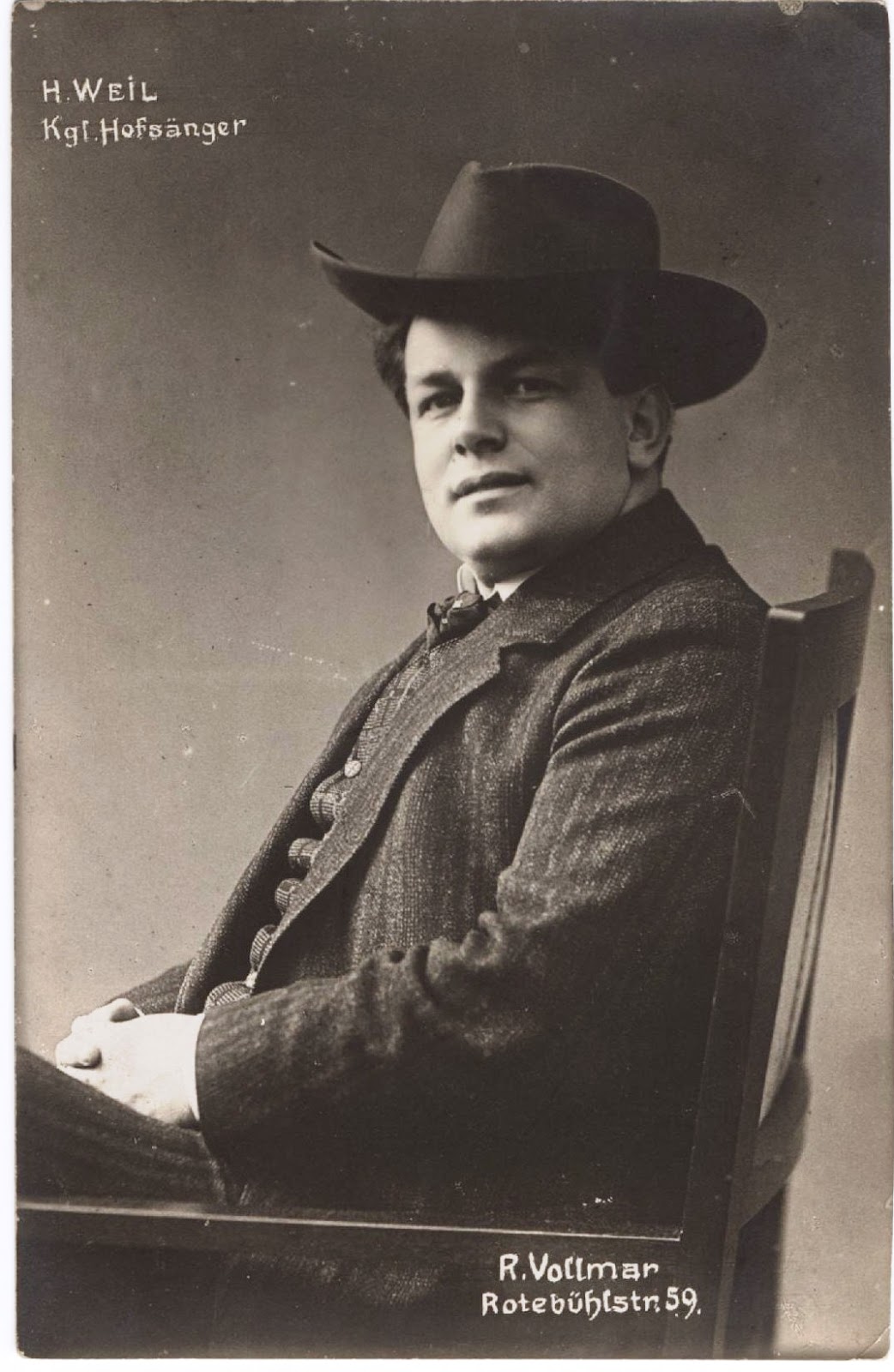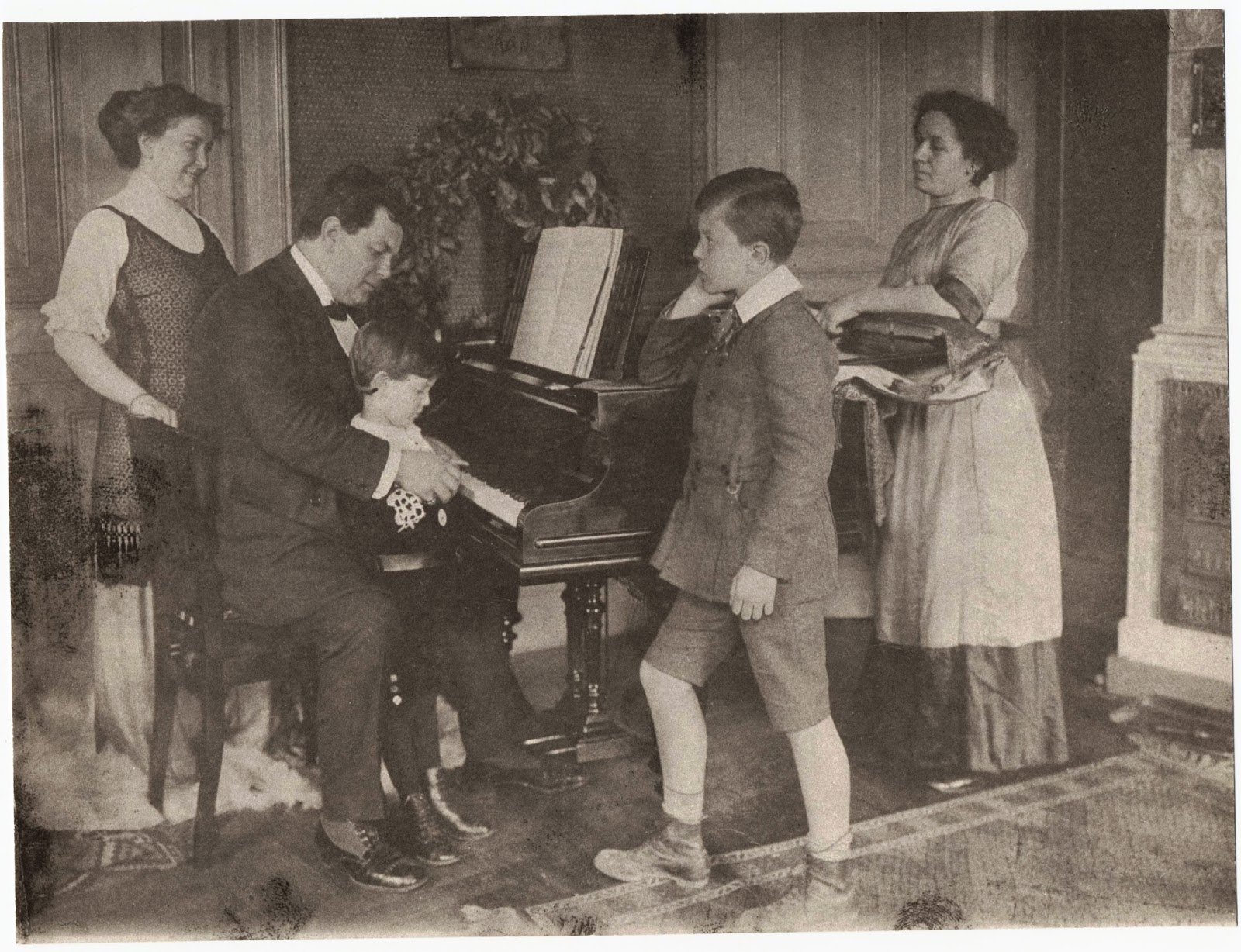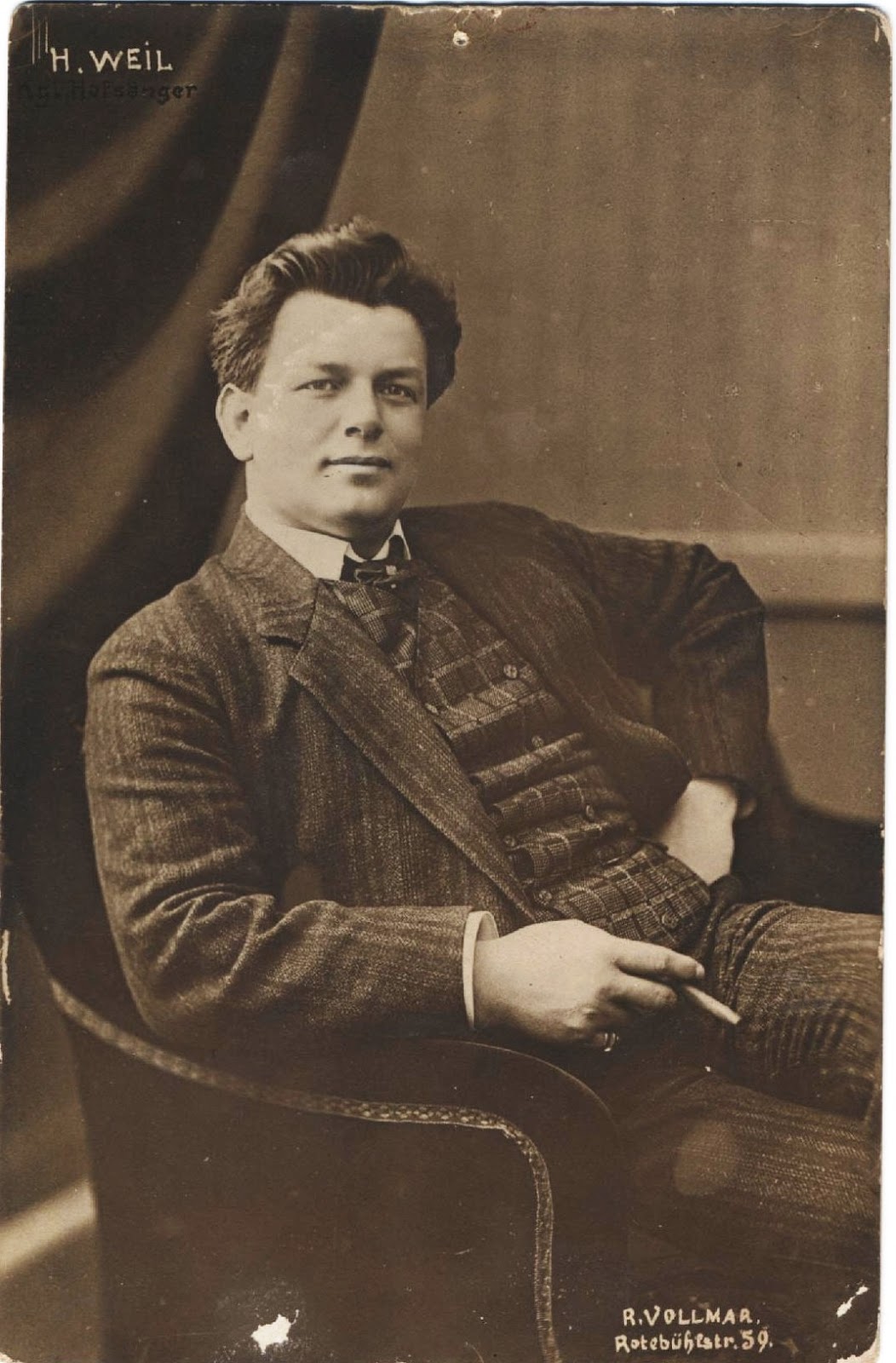 |
| Hermann Weil - all picture presented here by courtesy of BJ Weil |
About one and a half year ago, I got contact to Barbara Weil, the granddaughter of the baritone Hermann Weil. She sent me some pictures from the property of the family. I have kept them for a longer time, before now, today, I publish the second part of the recorded legacy of Herman Weil and on the same occasion share the pictures with other admirers of his fine singing and opera in the past.
Unfortunately, Mrs. Weil, who was born years after the death of her grandfather, has nearly no documents concerning Hermann Weil, and no remnants have survived in the family. It is only a rumour that Cosima Wagner once gave him a golden cup because she was so pleased with his performance in Bayreuth, because this relic does not seem to exist anymore. So here is not much of biographical information, which I can give, but a few nice photos from the life of Hermann Weil. All copies come from the possesion of Barbara Weil, and I am thankful that she gave me the allowance to publish them here.
 |
| Hermann Weil as a young man |
Hermann Weil was born on May, 29th, 1876, just precisely 138 years ago, in Mühlburg near Karlsruhe. He studied music theory and conducting at Karlsruhe under Felix Mottl and started as an accompanist at the Hoftheater of Karlsruhe in 1900. At the same time his voice was trained by Adolf Dippel from Frankfurt/Main. Weil made his debut as a singer in 1901 in Freiburg im Breisgau, a rather small town, in one of his latter "signature roles", the Wolfram in Tannhäuser. The photo above, which is photographed at Karlsruhe, should be from the time of his debut or even earlier. In 1904 he came to the Stuttgarter Hofoper, where he was very successful until 1933.
Seven years after his debut he was invited to sing in Bayreuth (which is a remarkable career!). In 1911 and 1912 he sang, alternating with Walter Soomer, Hans Sachs in Meistersinger. He also did, alternating with Werner Engel, Amfortas in Parsifal, and, alone, Gunther in Götterdämmerung. In 1914 he was not engaged in the Bayreuth festival when it was busted after a few performances because of the outbreak of the first World War, but in 1924, when the first Festspiele after the lost war reopened, he was again there and sang Hans Sachs. This he also did for a last time in 1925, alternating with Josef Correck.
I think that he lived in Stuttgart, but his participation in Bayreuth opened the doors to America, and from 1911 on he was very successful there. Here is the program from his debut at the Metropolitain Opera in New York on Nov. 17th, 1911. The role was Kurwenal in Tristan and Isolde, with Carl Burrian as Tristan and Olive Fremstad as Isolde.
100 years ago singing in America meant long sea journeys. Here is photo from the deck of "Kronprinzessin Cecilie", a big ship which was launched from the dock in 1907. I think Herman Weil is the man in the last row at the right, and I don't know who the others are.
 |
| On deck at "Kronprinzessin Cecilie" |
Here are a few portraits and role photos of Herman Weil.
 |
| Hermann Weil in private |
 |
| Hermann Weil, inscribed New York Feb. 1917, probably as Hans Sachs. Photo by Mishkin (Met) |
 |
| From the same photo session, inscribed Chrsitmas 1918 |
In 1917 he was interned as an enemy alien in the USA until 1919, but soon after the war he again toured through the USA. From 1920 to 1923 he was heard at the Vienna State Opera, but must have returned to America regularly, as a very fine photo from 1923 shows.
 |
| Hermann Weil, inscribed: To my dear son at the departure to America 1923 |
Another photo by the same (fine) photographer (I cannot decipher the name):
 |
| Hermann Weil in the 1920ies (?) |
Hermann Weil was married to Hanna Weil, née Kessler. Here are some photos of the family and his wife:
 |
| Hanna Kessler-Weil in 1916 |
 |
| Family life in Stuttgart: Hermann Weil with two children, housemaid (?) and wife. |
 |
| Hermann Weil am Klavier |
Herman Weil was a jew or had Jewish antecendants. I do not know about his troubles with the Nazi Regime. That his contract with the Stuttgart opera ended in 1933 may be a coincidence or his age of 59 years could have been the reason. As I read in the Sängerlexikon, he was forced to leave Germany in 1939. As he was used to living in America for many years, I think it was not as hard for him to get there as for other jewish people who wanted to leave Germany. In 1942 we have a photo from Maine with his wife, where he lookes rather lucky.
 |
| Hermann and Hanna Weil in Maine 1942 |
He died on July 6th 1949 from a heart attack while fishing on Blue Mountain Lake in the state of New York.
At the end, here is a last photo given by Barbara Weil of her grandfather with colleagues, most probably from Bayreuth 1924 or 1925. when Barbara Kemp sang Kundry in Parsifal, Rudolf Ritter sang Siegfried and Lauritz Melchior, the latter "Siegfried of the century", sang Siegmund and Parsifal.
 |
| Hermann Weil (3. v.l.) with Lauritz Melchior, Barbara Kemp und Rudolf Ritter, probably Bayreuth 1924 or 1925. |
Because it fits so well here, at last a photo from my collection. It is also a Bayreuth photo from 1924/25 with Hermann Weil. Here also you cannot make out by the involverd people, if it is from 1924 or 1925, as Willi Sonnen sang Fritz Kothner and Klingsor in 1924 and 25, just like Eduard Habich, who sang Alberich and Klingsor in these two years. Carl Braun sang Wotan and Gurnemanz in 1924 and Fasolt, Hunding and Hagen in 1925. Leo Schützendorf was a popular basso maybe for a visit on that day, as he did not sing in Bayreuth. He also had three singing brothers, so the second from the right could also be someone different from the Schützendorf familiy.
 |
| Hermann Weil, Lauritz Melchior, Eduard Habich (with bicycle), Carl Braun, (Leo ?) Schützendorf and Willi Sonnen, Bayreuth 1924 or 25 |


